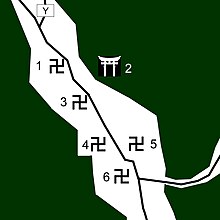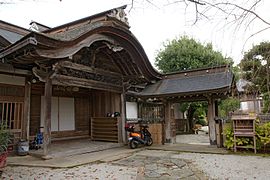Yoshino-yama
The Yoshino-yama ( Japanese 吉野 山 , also written 芳 野山 ) called the mountain region in the south of the Nara prefecture extends over about 8 km from the Yoshino river to the Ōmine mountain range. Their height is between 1000 and 1500 m. In its center is a small settlement with temples, shrines and the former seat of the so-called south courtyard during the split of the imperial family in the 14th century. The mountains are also famous for their cherry blossoms. In 2004, Yoshino was registered as a sacred place and pilgrimage in the Kii Mountains ( 紀 伊 山地 の 霊 場 と 参 指 道 , Kii zanchi reijō to sanshidō ) as a World Heritage Site .
history
The history of the region is linked to well-known historical figures. It is said that Emperor Jimmu once climbed the Kumano River here , Prince Nagasune fought there and Emperor Ōjin built a villa. Prince Ōama, who later became Emperor Temmu , withdrew to Yoshino to prepare for the attack on Emperor Kōbun in 672.
During the Heian period , emperors, members of the Fujiwara and other court aristocrats went on pilgrimages ( 参 詣 , sankei ) to the Kimpusen Temple ( 金峯 山寺 , Kimpusen-ji ). A shrine called Kane-no-miya Jinja, which was named Kongō Zaō Daigongen or Kongōbu-ji ( 金剛 部 寺 ), was built there very early . The priests of this temple became very powerful. They protected the emperors who often came there to admire the beautiful scenery. In 1185 Minamoto Yoshitsune sought refuge there when he was persecuted by his brother Yoritomo .
In 1332 Prince Moriyoshi raised soldiers with the help of the monks of the temple, converted the temple into a fortress and was able to withstand the attack of Nikaidō Dōun, a vassal of the Hōjō in 1333 . When Emperor Go-Daigo was expelled from Kyoto three years later , he sought refuge in Yoshino and established a residence there. After his death he was buried in the northeast corner of the temple. His son Go-Murakami was attacked by Kō no Moronao in 1348 and fled to Kawachi Province while the residence was destroyed.
Today the area is a popular destination, especially in spring, because of its history and its cherry trees. The most important section of the valley can be reached by taking the Kintetsu Yoshino Line cable car [Y] on the map.
Temples and shrines
- The catchment area of the Kimpusen Temple (Kimpusen-ji) is still marked today by the Black Gate ( 黒 門 , Kuromon ).
- The Kimpusen-ji ( 金峯 山寺 ) temple is the headquarters of a branch of the syncretic religion of the Shugendo . You enter him through the temple gate Niō-mon ( 仁王 門 ; national treasure ), which was rebuilt in 1456, with his two temple guards. These were created by Kōsai ( 康 成 ), a sculptor who also worked at the Tōdai Temple ( Tōdai-ji ) in Nara. The main hall of the temple Zaō-dō ( 蔵 王 堂 ; national treasure ) dates in its present form from the year 1592. After the Tōdai temple, this is the largest wooden hall in Japan. Its roof is supported by 68 wooden pillars, each made of just one natural log. According to tradition, the foundation stone of the temple should have been laid by the monk Gyōki in the Tempyō period (729-749) at the behest of the mountain ascetic En no Ozunu ( 役 小 角 ) . Originally this hall is said to have been built at a higher point. But since the pilgrimages were hindered by heavy snowfall in winter, this hall was built later. A temple settlement developed there over the years. In addition to the national treasures, the temple also has a number of important cultural assets .
- The Tennō Go-Daigo once resided in the Yoshimizu Shrine ( 吉 水 神社 , Yoshimizu-jinja ).
- On the grounds of the Tōnan-in ( 東南 院 ) temple is u. a. a treasure pagoda ( 多 宝塔 , tahōtō ). This once stood in the Nokami Hachimangū Shrine (Wakayama Prefecture) and was moved to Yoshino in 1937. A statue of Dainichi nyorai ( 大 日 如 来 ) is venerated .
- The Dainichi-dera ( 大 日 寺 ) was the burial temple ( 菩提 寺 , bodai-ji ) of Murakami Yoshimitsu and his son Yoshitaka. A statue of Gochi nyorai ( 五 知 如 来 ; important cultural asset ) is venerated in the temple .
- The Kizō-in ( 喜 蔵 院 ) was built as a sub-temple ( 塔 頭 , tatchū ) of the Kimpusen Temple. In 1796 36 cherry trees of the kind Mikumaroka ( 三 熊 露 香 ) were planted there.
- The now secularized temple Chikurin-in ( 竹林 院 ) with a well-known garden is said to have been founded by Kūkai in 818.
- The Katte-jinja ( 勝 手 神社 ) shrine is now dedicated to the deity Amenooshihomimi .
- The Sakura Motobō ( 桜 本 坊 ) temple is dedicated to the mountain ascetic En no Gyōja .
- The Nyoirin-ji ( 如意輪 寺 ) temple, founded between 901 and 922, is used to worship the Nyoirin-Kannon.
- In the Mikumari shrine Mikumari Jinja ( 水分 神社 ) on a higher mountain ridge, the deity Ame-no-mikumari-no-ōkami is worshiped.
The cherry trees of Yoshino
According to tradition, the legendary pilgrim En-no-Ozunu ( 役 小 角 ), also called En-no-Gyōsha ( 役 業 者 ), is said to have brought a cherry tree as a gift at the end of the 7th century . In 1538, Sueyoshi Kambei, who owns merchant ships, is said to have donated 10,000 trees. At the beginning of the Meiji period , in the course of the suppression of Buddhism ( 廃 仏 毀 釈 , Haibutsu kishaku ), many trees were destroyed, but the residents resisted, so that the cherry trees were replanted and nationally recognized as " Traces of History and Beautiful View" ( 史跡 ・ 名勝 , shiseki meishō ) were declared.
The landscape of Yoshino is the subject of many poems and pictorial representations. Matsuo Basho , who visited Yoshino several times, wrote the following haiku, among other things: "In Yoshino: cherry blossoms under a cedar umbrella."
Individual evidence
- ↑ 「吉野 に て 桜 見 せ う ぞ 檜 木 傘」 In: Kon, Eizō: Bashō kushū. Shinchō-sha, 1982. Haiku 379.
literature
- Nara-ken kotogakko-kyoka token kenkyu-kyokai rekishi bukai (Hrg): Nara-ken no rekishi sampo (ge). Yamakawa Shuppan, 2010. ISBN 978-4-634-24829-8 .
- Suzuki, Toshihiko (ed.): Yohino-yama In: Nihon daihyakka zensho (Denshibukku-han), Shogakukan, 1996.
- Edmond Papinot: Historical and Geographical Dictionary of Japan. Reprint of the 1910 edition. Tuttle, 1972, ISBN 0-8048-0996-8 .
gallery
Coordinates: 34 ° 22 ′ 6 ″ N , 135 ° 51 ′ 32 ″ E







